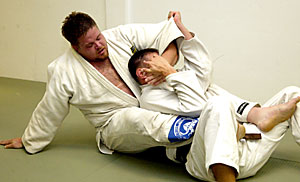 |
|
KEVIN B. KLAUS/Arizona Summer Wildcat
|
Educational psychology graduate student Dusty Alexander practices his jiu-jitsu technique on Monday night at The Ultima on Thornydale Road Alexander will be going to Brazil July 22-25 to compete in the 2004 Jujitsu World Championship.
|
|
|
By Kylee Dawson
Arizona Daily Wildcat
Wednesday, June 30, 2004
Print this
If you go to Rio de Janeiro, Brazil, anytime soon, be mindful of who you pick a fight with. Especially from July 22-25.
During those days, UA student Dusty Alexander and UA alums Rick Bueno and Steve McDonald are just three of the many athletes who will compete at the 2004 International Jiu-Jitsu World Championship.
The three athletes are in the process of raising the $4,000 needed for their trip. Sponsors who have contributed to their fund include "a lot of car dealerships, small private company owners and regular people," said Alexander.
"Our chances are pretty good, even for the gold," Bueno said about his team's chances of winning the championship.
"We've all been training very hard," McDonald said. "We've had a lot of support from everybody, especially here at Ultima." Ultima is a martial arts center in Tucson where he and Bueno teach various martial arts.
Brazilian jiu-jitsu instructor Pedro Sauer is the teams' affiliate for the World Championship. The Brazil native has a 6th-degree black belt.
"He's our main instructor for the United States," Bueno said. "Here it's good to be affiliated with a black belt."
Bueno, also a Brazil native, has been studying Brazilian jiu-jitsu for over 12 years under the tutelage of Master Pedro Hemeterio, a 9th-degree red belt who, at 82 years old, has been teaching the martial art for over 60 years.
"It makes me very proud to keep that martial art going on," said Bueno, who also teaches Brazilian jiu-jitsu.
Hemeterio himself studied Brazilian jiu-jitsu with Helio Gracie, who, along with his older brother Carlos, developed the Brazilian adaptation of the Japanese martial art.
The Gracies learned traditional Japanese jiu-jitsu from a Japanese diplomat in the 1930s, which was then "developed into a more realistic fighting system," Bueno said.
But it was Helio who helped popularize Brazilian jiu-jitsu by patenting it to fit the street fighting style in Brazil.
"He participated in a bunch of no-holds-barred events in Brazil," Bueno said. "He was a very tough fighter and that's how jiu-jitsu started to get more and more popular."
At 92, Helio is a 10th-degree red belt and still training students in Brazil.
"He teaches classes everyday and at the end of class, he's the one that does the thousand abs that you're required," Bueno said speaking of abdominal exercises. "He's still in awesome shape."
When he goes to Brazil to compete, Bueno hopes to continue his training with Master Hemeterio.
At the World Championship, "I'm going to be competing for them," Bueno said of Hemeterio and Helio.
Before Brazilian jiu-jitsu, Bueno first studied kickboxing and capoeira, an Afro-Brazilian martial art.
Tucson native Alexander, an educational psychology graduate student, began studying Brazilian jiu-jitsu over a year ago after sustaining a football injury.
"This is straight-up, anything goes fighting for Brazil," Alexander said, describing jiu-jitsu.
When he realized Brazilian jiu-jitsu did not aggravate his injury, and noticed everyone from six-year-olds to 70-year-olds practicing it, he realized it was a sport that could be practiced over a long time.
"My biggest thing in life is that I need to compete in something, so this gives me a reason to compete," Alexander said.
This competitive spirit worked in Alexander's favor at the 10th Pan American Jiu-jitsu Championship in Los Angeles last April, where he received the gold medal in the super-super heavyweight blue belt division.
Alexander's own instructor, Bueno, won the silver medal in the lightweight purple division and McDonald won the bronze medal in the lightweight blue belt division. Alexander said it is interesting for three members of one "dojo," or school for martial arts training, to all win prizes at a championship.
Even though it is mandatory to be at least a blue belt to compete, Alexander did not officially receive his blue belt until this Saturday at an official ceremony hosted by Sauer. Seven additional blue belts, three purple belts and two brown belts were also distributed to students.
During the ceremony, Bueno also received a brown belt, but he will fight at the World Championship as a purple belt since that was the ranking with which he qualified to compete.
The belt ranking system in Brazilian jiu-jitsu goes as follows: white, blue, purple, brown, black and red, which is a "master belt," according to Bueno.
"You get a black belt then you go 10 degrees and you get a red belt."
"It takes years of practice (to get a black belt)," Bueno said. "We still, at the Ultima, use the Brazilian belt ranking system. And no offense here, but (in the U.S.) they're giving the belts away a little too easily. And in Brazil, in order to receive a black belt, you need to have between 10 to 15 years of training."
For more information about learning jiu-jitsu and other martial arts check out the Ultima Martial Arts Centers on 6781 N. Thornydale Rd. #219 and 7649 E. Speedway Blvd.

